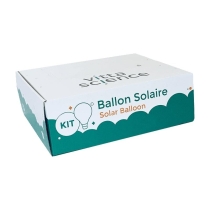
Solar Balloon - micro:bit version
Comment noteriez-vous cet article?
Notez-le sur 5

Take your projects to new heights with the Vittascience Solar Balloon Experience!
Feel the thrill of launching a flying object you’ve built entirely yourself. This complete kit lets you create a solar balloon capable of reaching up to 50 meters in altitude while carrying a connected payload of up to 1 kg.
Using the micro:bit board and a range of environmental sensors, you can program and collect data on temperature, pressure, altitude, CO₂ levels, and more. A captivating experience that combines building, electronics, and data analysis—tested and loved by makers and educators around the world.
Kit contents:
Compliant with regulations: the balloon is limited to 50 m altitude using the included cords.
After the flight, retrieve the payload and analyze the collected data to power your scientific or technical projects.
Manufacturer: Vittascience
Product reference: 3760327670023
Soyez le premier à donner votre avis sur ce produit !